Fault Line: Indigenous-Settler in Western Canada & Settler Colonialism
VerifiedAdded on 2022/08/26
|8
|1991
|11
Essay
AI Summary
This essay delves into the complex and often contentious relationship between Indigenous peoples and settlers in Western Canada, examining the historical context and contemporary issues that define this fault line. It begins by introducing the concept of settler colonialism and its impact on Indigenous communities, exploring how it has shaped regional identity and led to ongoing conflicts, such as the Trans Mountain Pipeline expansion. The essay traces the history of Indigenous-Settler interactions, highlighting the arrival of settlers, the establishment of the Prairie Provinces, and the resulting social, economic, and political tensions. It discusses the various Indigenous groups in Western Canada, including the First Nations, Metis, and Inuits, and analyzes the impact of policies and events on their rights and freedoms. Furthermore, the essay examines the challenges faced by Indigenous communities, including the loss of land, cultural suppression, and the ongoing struggle for self-determination. By exploring these issues, the essay aims to shed light on the current scenario of fault line that exists between Indigenous-Settlers who are based in Western Canada.
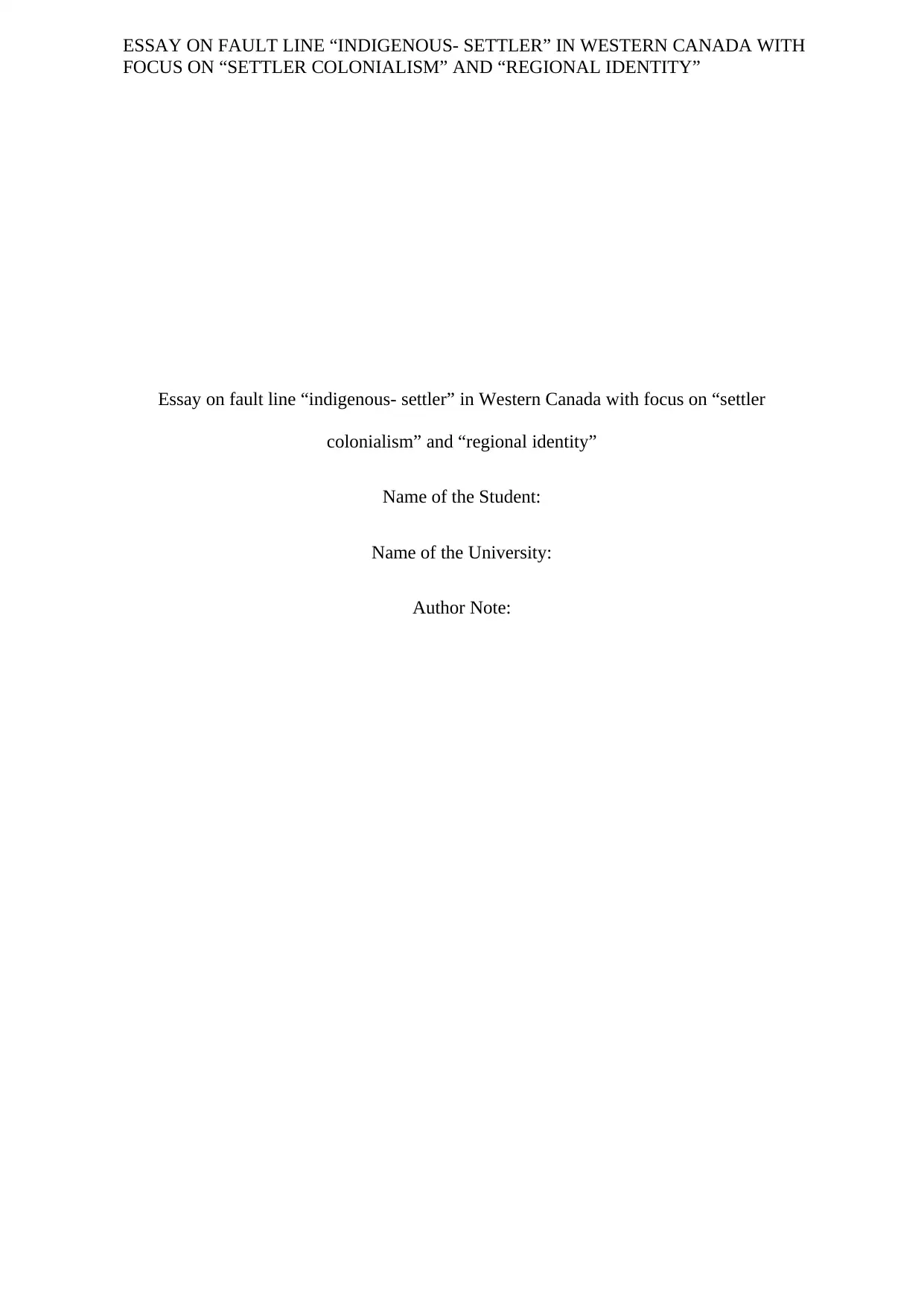
ESSAY ON FAULT LINE “INDIGENOUS- SETTLER” IN WESTERN CANADA WITH
FOCUS ON “SETTLER COLONIALISM” AND “REGIONAL IDENTITY”
Essay on fault line “indigenous- settler” in Western Canada with focus on “settler
colonialism” and “regional identity”
Name of the Student:
Name of the University:
Author Note:
FOCUS ON “SETTLER COLONIALISM” AND “REGIONAL IDENTITY”
Essay on fault line “indigenous- settler” in Western Canada with focus on “settler
colonialism” and “regional identity”
Name of the Student:
Name of the University:
Author Note:
Paraphrase This Document
Need a fresh take? Get an instant paraphrase of this document with our AI Paraphraser
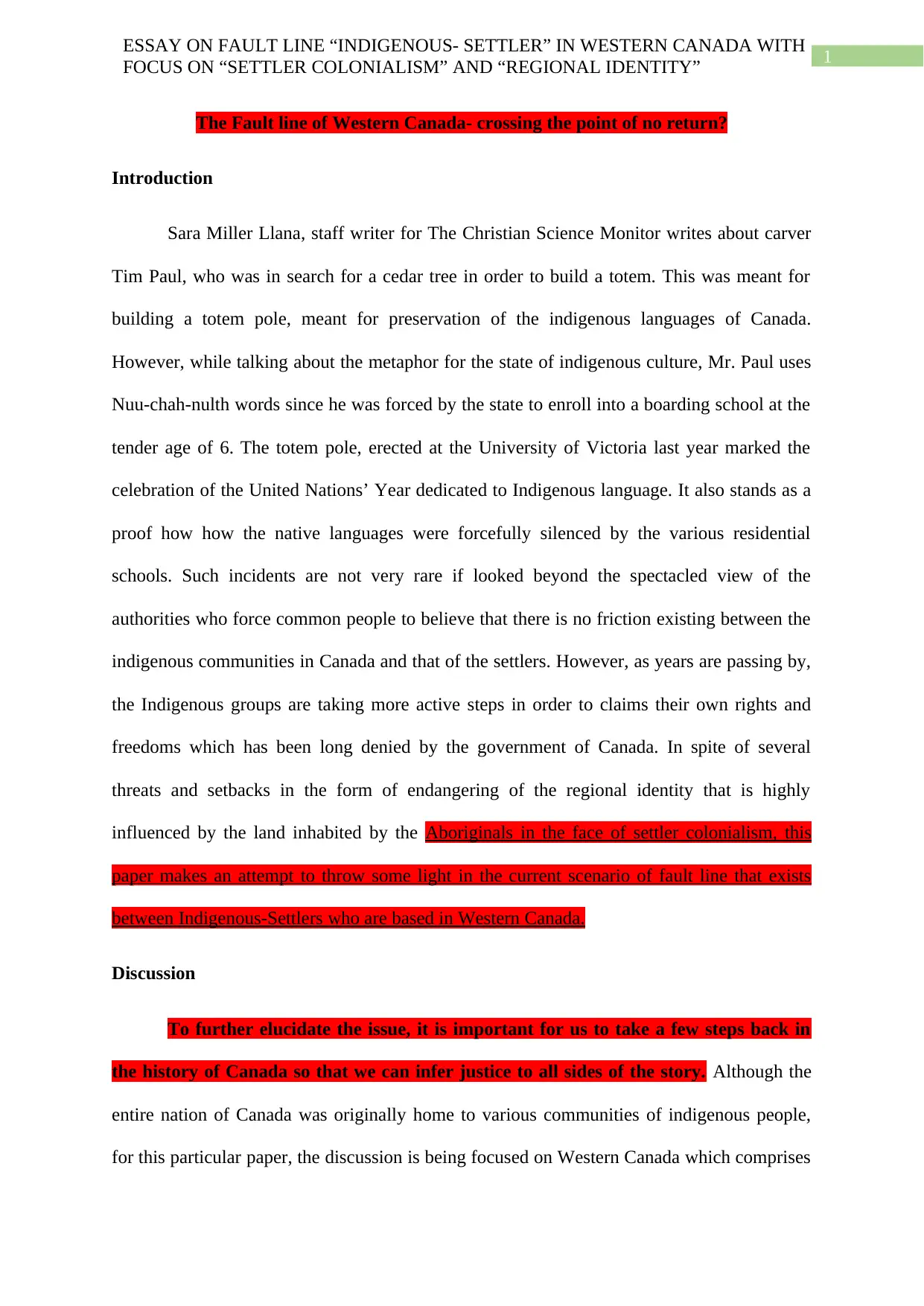
1
ESSAY ON FAULT LINE “INDIGENOUS- SETTLER” IN WESTERN CANADA WITH
FOCUS ON “SETTLER COLONIALISM” AND “REGIONAL IDENTITY”
The Fault line of Western Canada- crossing the point of no return?
Introduction
Sara Miller Llana, staff writer for The Christian Science Monitor writes about carver
Tim Paul, who was in search for a cedar tree in order to build a totem. This was meant for
building a totem pole, meant for preservation of the indigenous languages of Canada.
However, while talking about the metaphor for the state of indigenous culture, Mr. Paul uses
Nuu-chah-nulth words since he was forced by the state to enroll into a boarding school at the
tender age of 6. The totem pole, erected at the University of Victoria last year marked the
celebration of the United Nations’ Year dedicated to Indigenous language. It also stands as a
proof how how the native languages were forcefully silenced by the various residential
schools. Such incidents are not very rare if looked beyond the spectacled view of the
authorities who force common people to believe that there is no friction existing between the
indigenous communities in Canada and that of the settlers. However, as years are passing by,
the Indigenous groups are taking more active steps in order to claims their own rights and
freedoms which has been long denied by the government of Canada. In spite of several
threats and setbacks in the form of endangering of the regional identity that is highly
influenced by the land inhabited by the Aboriginals in the face of settler colonialism, this
paper makes an attempt to throw some light in the current scenario of fault line that exists
between Indigenous-Settlers who are based in Western Canada.
Discussion
To further elucidate the issue, it is important for us to take a few steps back in
the history of Canada so that we can infer justice to all sides of the story. Although the
entire nation of Canada was originally home to various communities of indigenous people,
for this particular paper, the discussion is being focused on Western Canada which comprises
ESSAY ON FAULT LINE “INDIGENOUS- SETTLER” IN WESTERN CANADA WITH
FOCUS ON “SETTLER COLONIALISM” AND “REGIONAL IDENTITY”
The Fault line of Western Canada- crossing the point of no return?
Introduction
Sara Miller Llana, staff writer for The Christian Science Monitor writes about carver
Tim Paul, who was in search for a cedar tree in order to build a totem. This was meant for
building a totem pole, meant for preservation of the indigenous languages of Canada.
However, while talking about the metaphor for the state of indigenous culture, Mr. Paul uses
Nuu-chah-nulth words since he was forced by the state to enroll into a boarding school at the
tender age of 6. The totem pole, erected at the University of Victoria last year marked the
celebration of the United Nations’ Year dedicated to Indigenous language. It also stands as a
proof how how the native languages were forcefully silenced by the various residential
schools. Such incidents are not very rare if looked beyond the spectacled view of the
authorities who force common people to believe that there is no friction existing between the
indigenous communities in Canada and that of the settlers. However, as years are passing by,
the Indigenous groups are taking more active steps in order to claims their own rights and
freedoms which has been long denied by the government of Canada. In spite of several
threats and setbacks in the form of endangering of the regional identity that is highly
influenced by the land inhabited by the Aboriginals in the face of settler colonialism, this
paper makes an attempt to throw some light in the current scenario of fault line that exists
between Indigenous-Settlers who are based in Western Canada.
Discussion
To further elucidate the issue, it is important for us to take a few steps back in
the history of Canada so that we can infer justice to all sides of the story. Although the
entire nation of Canada was originally home to various communities of indigenous people,
for this particular paper, the discussion is being focused on Western Canada which comprises
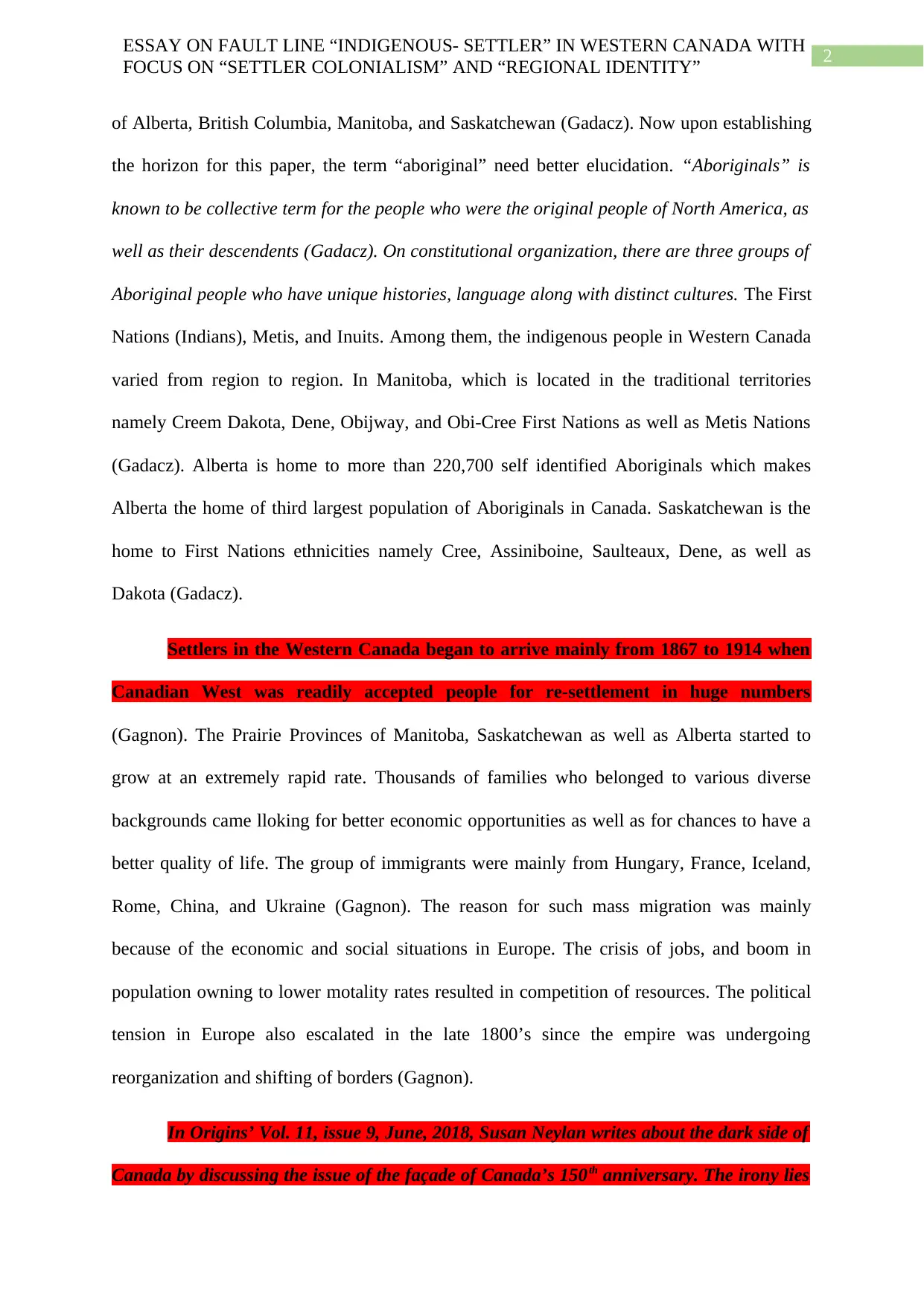
2
ESSAY ON FAULT LINE “INDIGENOUS- SETTLER” IN WESTERN CANADA WITH
FOCUS ON “SETTLER COLONIALISM” AND “REGIONAL IDENTITY”
of Alberta, British Columbia, Manitoba, and Saskatchewan (Gadacz). Now upon establishing
the horizon for this paper, the term “aboriginal” need better elucidation. “Aboriginals” is
known to be collective term for the people who were the original people of North America, as
well as their descendents (Gadacz). On constitutional organization, there are three groups of
Aboriginal people who have unique histories, language along with distinct cultures. The First
Nations (Indians), Metis, and Inuits. Among them, the indigenous people in Western Canada
varied from region to region. In Manitoba, which is located in the traditional territories
namely Creem Dakota, Dene, Obijway, and Obi-Cree First Nations as well as Metis Nations
(Gadacz). Alberta is home to more than 220,700 self identified Aboriginals which makes
Alberta the home of third largest population of Aboriginals in Canada. Saskatchewan is the
home to First Nations ethnicities namely Cree, Assiniboine, Saulteaux, Dene, as well as
Dakota (Gadacz).
Settlers in the Western Canada began to arrive mainly from 1867 to 1914 when
Canadian West was readily accepted people for re-settlement in huge numbers
(Gagnon). The Prairie Provinces of Manitoba, Saskatchewan as well as Alberta started to
grow at an extremely rapid rate. Thousands of families who belonged to various diverse
backgrounds came lloking for better economic opportunities as well as for chances to have a
better quality of life. The group of immigrants were mainly from Hungary, France, Iceland,
Rome, China, and Ukraine (Gagnon). The reason for such mass migration was mainly
because of the economic and social situations in Europe. The crisis of jobs, and boom in
population owning to lower motality rates resulted in competition of resources. The political
tension in Europe also escalated in the late 1800’s since the empire was undergoing
reorganization and shifting of borders (Gagnon).
In Origins’ Vol. 11, issue 9, June, 2018, Susan Neylan writes about the dark side of
Canada by discussing the issue of the façade of Canada’s 150th anniversary. The irony lies
ESSAY ON FAULT LINE “INDIGENOUS- SETTLER” IN WESTERN CANADA WITH
FOCUS ON “SETTLER COLONIALISM” AND “REGIONAL IDENTITY”
of Alberta, British Columbia, Manitoba, and Saskatchewan (Gadacz). Now upon establishing
the horizon for this paper, the term “aboriginal” need better elucidation. “Aboriginals” is
known to be collective term for the people who were the original people of North America, as
well as their descendents (Gadacz). On constitutional organization, there are three groups of
Aboriginal people who have unique histories, language along with distinct cultures. The First
Nations (Indians), Metis, and Inuits. Among them, the indigenous people in Western Canada
varied from region to region. In Manitoba, which is located in the traditional territories
namely Creem Dakota, Dene, Obijway, and Obi-Cree First Nations as well as Metis Nations
(Gadacz). Alberta is home to more than 220,700 self identified Aboriginals which makes
Alberta the home of third largest population of Aboriginals in Canada. Saskatchewan is the
home to First Nations ethnicities namely Cree, Assiniboine, Saulteaux, Dene, as well as
Dakota (Gadacz).
Settlers in the Western Canada began to arrive mainly from 1867 to 1914 when
Canadian West was readily accepted people for re-settlement in huge numbers
(Gagnon). The Prairie Provinces of Manitoba, Saskatchewan as well as Alberta started to
grow at an extremely rapid rate. Thousands of families who belonged to various diverse
backgrounds came lloking for better economic opportunities as well as for chances to have a
better quality of life. The group of immigrants were mainly from Hungary, France, Iceland,
Rome, China, and Ukraine (Gagnon). The reason for such mass migration was mainly
because of the economic and social situations in Europe. The crisis of jobs, and boom in
population owning to lower motality rates resulted in competition of resources. The political
tension in Europe also escalated in the late 1800’s since the empire was undergoing
reorganization and shifting of borders (Gagnon).
In Origins’ Vol. 11, issue 9, June, 2018, Susan Neylan writes about the dark side of
Canada by discussing the issue of the façade of Canada’s 150th anniversary. The irony lies
⊘ This is a preview!⊘
Do you want full access?
Subscribe today to unlock all pages.

Trusted by 1+ million students worldwide
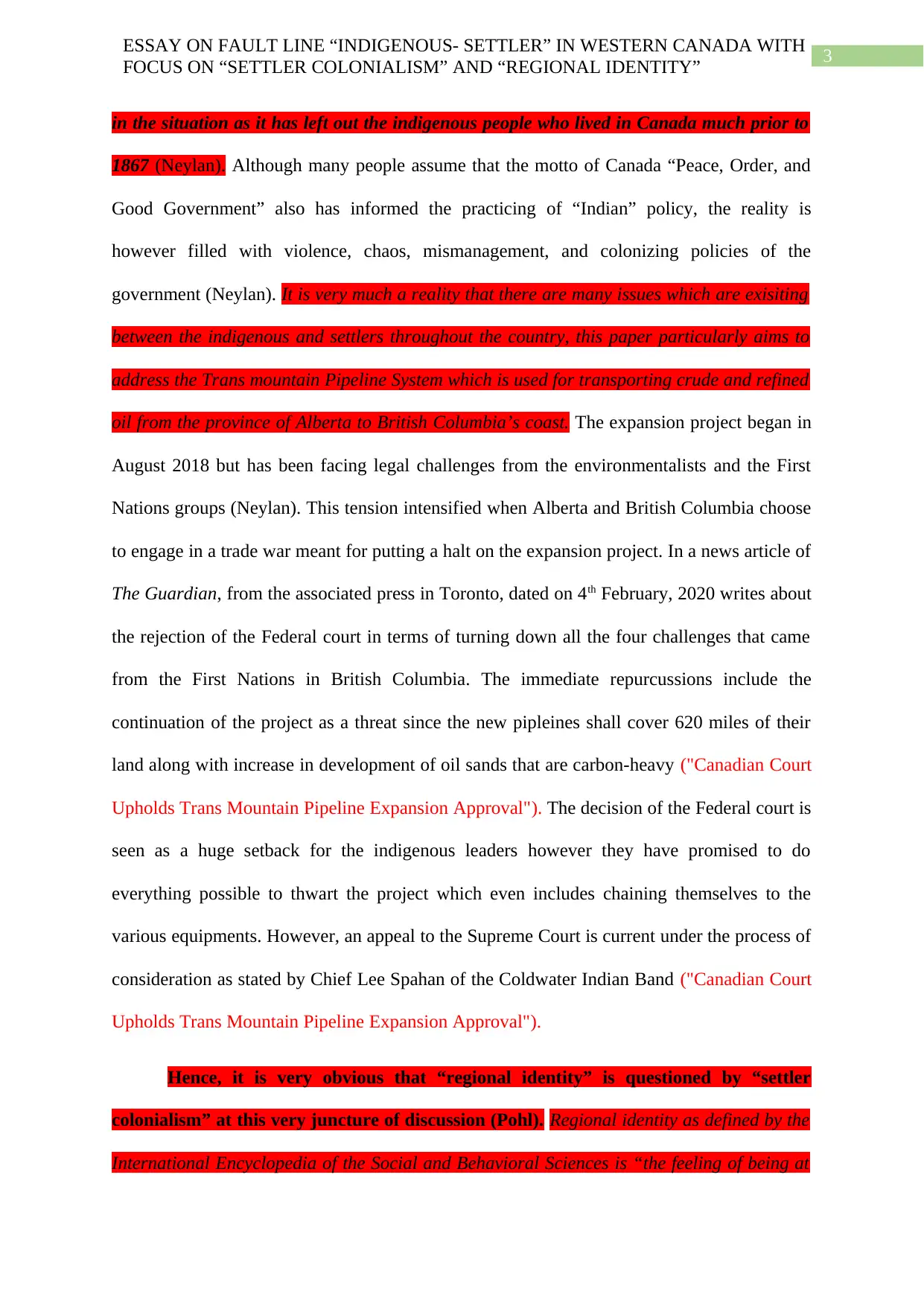
3
ESSAY ON FAULT LINE “INDIGENOUS- SETTLER” IN WESTERN CANADA WITH
FOCUS ON “SETTLER COLONIALISM” AND “REGIONAL IDENTITY”
in the situation as it has left out the indigenous people who lived in Canada much prior to
1867 (Neylan). Although many people assume that the motto of Canada “Peace, Order, and
Good Government” also has informed the practicing of “Indian” policy, the reality is
however filled with violence, chaos, mismanagement, and colonizing policies of the
government (Neylan). It is very much a reality that there are many issues which are exisiting
between the indigenous and settlers throughout the country, this paper particularly aims to
address the Trans mountain Pipeline System which is used for transporting crude and refined
oil from the province of Alberta to British Columbia’s coast. The expansion project began in
August 2018 but has been facing legal challenges from the environmentalists and the First
Nations groups (Neylan). This tension intensified when Alberta and British Columbia choose
to engage in a trade war meant for putting a halt on the expansion project. In a news article of
The Guardian, from the associated press in Toronto, dated on 4th February, 2020 writes about
the rejection of the Federal court in terms of turning down all the four challenges that came
from the First Nations in British Columbia. The immediate repurcussions include the
continuation of the project as a threat since the new pipleines shall cover 620 miles of their
land along with increase in development of oil sands that are carbon-heavy ("Canadian Court
Upholds Trans Mountain Pipeline Expansion Approval"). The decision of the Federal court is
seen as a huge setback for the indigenous leaders however they have promised to do
everything possible to thwart the project which even includes chaining themselves to the
various equipments. However, an appeal to the Supreme Court is current under the process of
consideration as stated by Chief Lee Spahan of the Coldwater Indian Band ("Canadian Court
Upholds Trans Mountain Pipeline Expansion Approval").
Hence, it is very obvious that “regional identity” is questioned by “settler
colonialism” at this very juncture of discussion (Pohl). Regional identity as defined by the
International Encyclopedia of the Social and Behavioral Sciences is “the feeling of being at
ESSAY ON FAULT LINE “INDIGENOUS- SETTLER” IN WESTERN CANADA WITH
FOCUS ON “SETTLER COLONIALISM” AND “REGIONAL IDENTITY”
in the situation as it has left out the indigenous people who lived in Canada much prior to
1867 (Neylan). Although many people assume that the motto of Canada “Peace, Order, and
Good Government” also has informed the practicing of “Indian” policy, the reality is
however filled with violence, chaos, mismanagement, and colonizing policies of the
government (Neylan). It is very much a reality that there are many issues which are exisiting
between the indigenous and settlers throughout the country, this paper particularly aims to
address the Trans mountain Pipeline System which is used for transporting crude and refined
oil from the province of Alberta to British Columbia’s coast. The expansion project began in
August 2018 but has been facing legal challenges from the environmentalists and the First
Nations groups (Neylan). This tension intensified when Alberta and British Columbia choose
to engage in a trade war meant for putting a halt on the expansion project. In a news article of
The Guardian, from the associated press in Toronto, dated on 4th February, 2020 writes about
the rejection of the Federal court in terms of turning down all the four challenges that came
from the First Nations in British Columbia. The immediate repurcussions include the
continuation of the project as a threat since the new pipleines shall cover 620 miles of their
land along with increase in development of oil sands that are carbon-heavy ("Canadian Court
Upholds Trans Mountain Pipeline Expansion Approval"). The decision of the Federal court is
seen as a huge setback for the indigenous leaders however they have promised to do
everything possible to thwart the project which even includes chaining themselves to the
various equipments. However, an appeal to the Supreme Court is current under the process of
consideration as stated by Chief Lee Spahan of the Coldwater Indian Band ("Canadian Court
Upholds Trans Mountain Pipeline Expansion Approval").
Hence, it is very obvious that “regional identity” is questioned by “settler
colonialism” at this very juncture of discussion (Pohl). Regional identity as defined by the
International Encyclopedia of the Social and Behavioral Sciences is “the feeling of being at
Paraphrase This Document
Need a fresh take? Get an instant paraphrase of this document with our AI Paraphraser
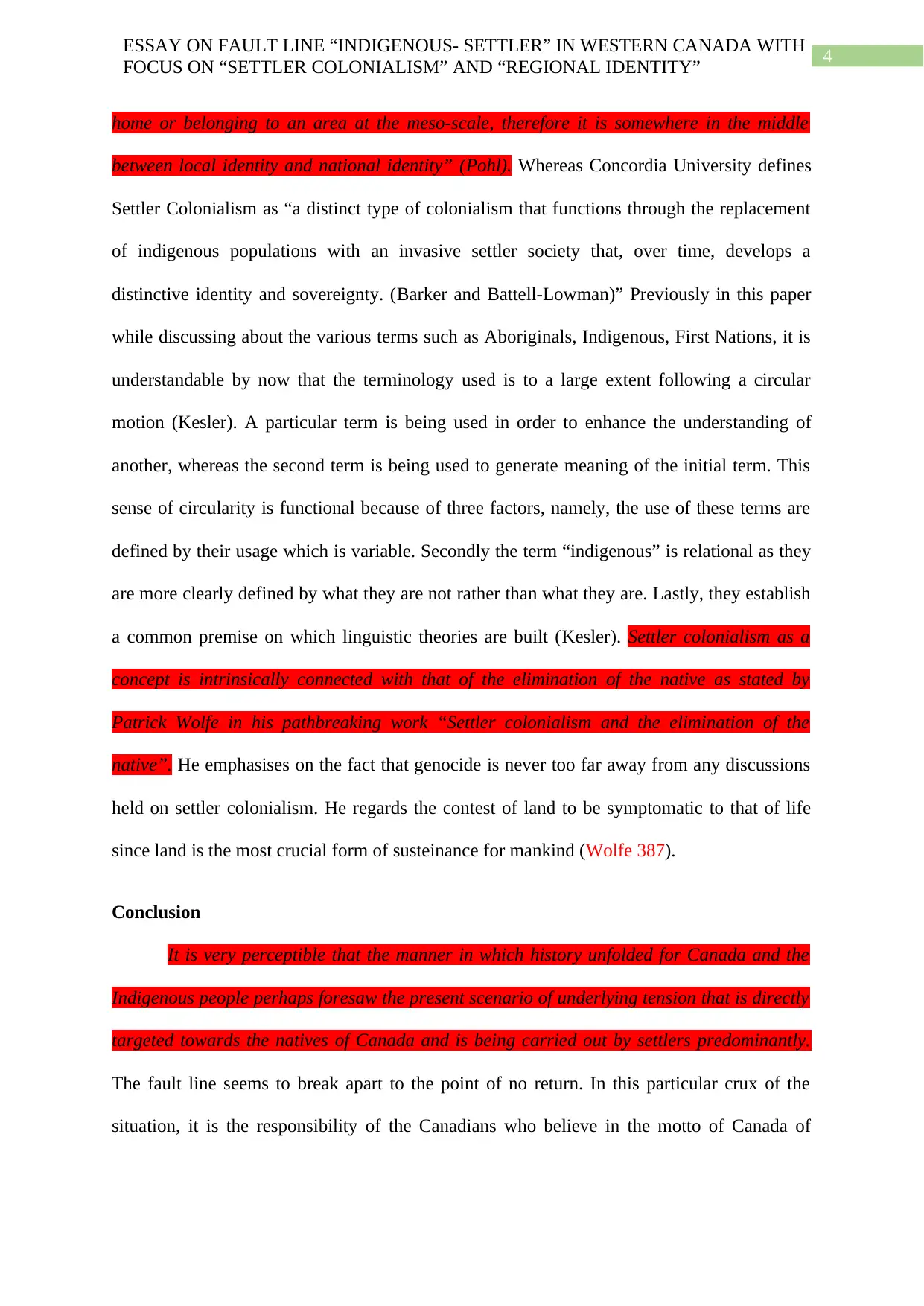
4
ESSAY ON FAULT LINE “INDIGENOUS- SETTLER” IN WESTERN CANADA WITH
FOCUS ON “SETTLER COLONIALISM” AND “REGIONAL IDENTITY”
home or belonging to an area at the meso-scale, therefore it is somewhere in the middle
between local identity and national identity” (Pohl). Whereas Concordia University defines
Settler Colonialism as “a distinct type of colonialism that functions through the replacement
of indigenous populations with an invasive settler society that, over time, develops a
distinctive identity and sovereignty. (Barker and Battell-Lowman)” Previously in this paper
while discussing about the various terms such as Aboriginals, Indigenous, First Nations, it is
understandable by now that the terminology used is to a large extent following a circular
motion (Kesler). A particular term is being used in order to enhance the understanding of
another, whereas the second term is being used to generate meaning of the initial term. This
sense of circularity is functional because of three factors, namely, the use of these terms are
defined by their usage which is variable. Secondly the term “indigenous” is relational as they
are more clearly defined by what they are not rather than what they are. Lastly, they establish
a common premise on which linguistic theories are built (Kesler). Settler colonialism as a
concept is intrinsically connected with that of the elimination of the native as stated by
Patrick Wolfe in his pathbreaking work “Settler colonialism and the elimination of the
native”. He emphasises on the fact that genocide is never too far away from any discussions
held on settler colonialism. He regards the contest of land to be symptomatic to that of life
since land is the most crucial form of susteinance for mankind (Wolfe 387).
Conclusion
It is very perceptible that the manner in which history unfolded for Canada and the
Indigenous people perhaps foresaw the present scenario of underlying tension that is directly
targeted towards the natives of Canada and is being carried out by settlers predominantly.
The fault line seems to break apart to the point of no return. In this particular crux of the
situation, it is the responsibility of the Canadians who believe in the motto of Canada of
ESSAY ON FAULT LINE “INDIGENOUS- SETTLER” IN WESTERN CANADA WITH
FOCUS ON “SETTLER COLONIALISM” AND “REGIONAL IDENTITY”
home or belonging to an area at the meso-scale, therefore it is somewhere in the middle
between local identity and national identity” (Pohl). Whereas Concordia University defines
Settler Colonialism as “a distinct type of colonialism that functions through the replacement
of indigenous populations with an invasive settler society that, over time, develops a
distinctive identity and sovereignty. (Barker and Battell-Lowman)” Previously in this paper
while discussing about the various terms such as Aboriginals, Indigenous, First Nations, it is
understandable by now that the terminology used is to a large extent following a circular
motion (Kesler). A particular term is being used in order to enhance the understanding of
another, whereas the second term is being used to generate meaning of the initial term. This
sense of circularity is functional because of three factors, namely, the use of these terms are
defined by their usage which is variable. Secondly the term “indigenous” is relational as they
are more clearly defined by what they are not rather than what they are. Lastly, they establish
a common premise on which linguistic theories are built (Kesler). Settler colonialism as a
concept is intrinsically connected with that of the elimination of the native as stated by
Patrick Wolfe in his pathbreaking work “Settler colonialism and the elimination of the
native”. He emphasises on the fact that genocide is never too far away from any discussions
held on settler colonialism. He regards the contest of land to be symptomatic to that of life
since land is the most crucial form of susteinance for mankind (Wolfe 387).
Conclusion
It is very perceptible that the manner in which history unfolded for Canada and the
Indigenous people perhaps foresaw the present scenario of underlying tension that is directly
targeted towards the natives of Canada and is being carried out by settlers predominantly.
The fault line seems to break apart to the point of no return. In this particular crux of the
situation, it is the responsibility of the Canadians who believe in the motto of Canada of
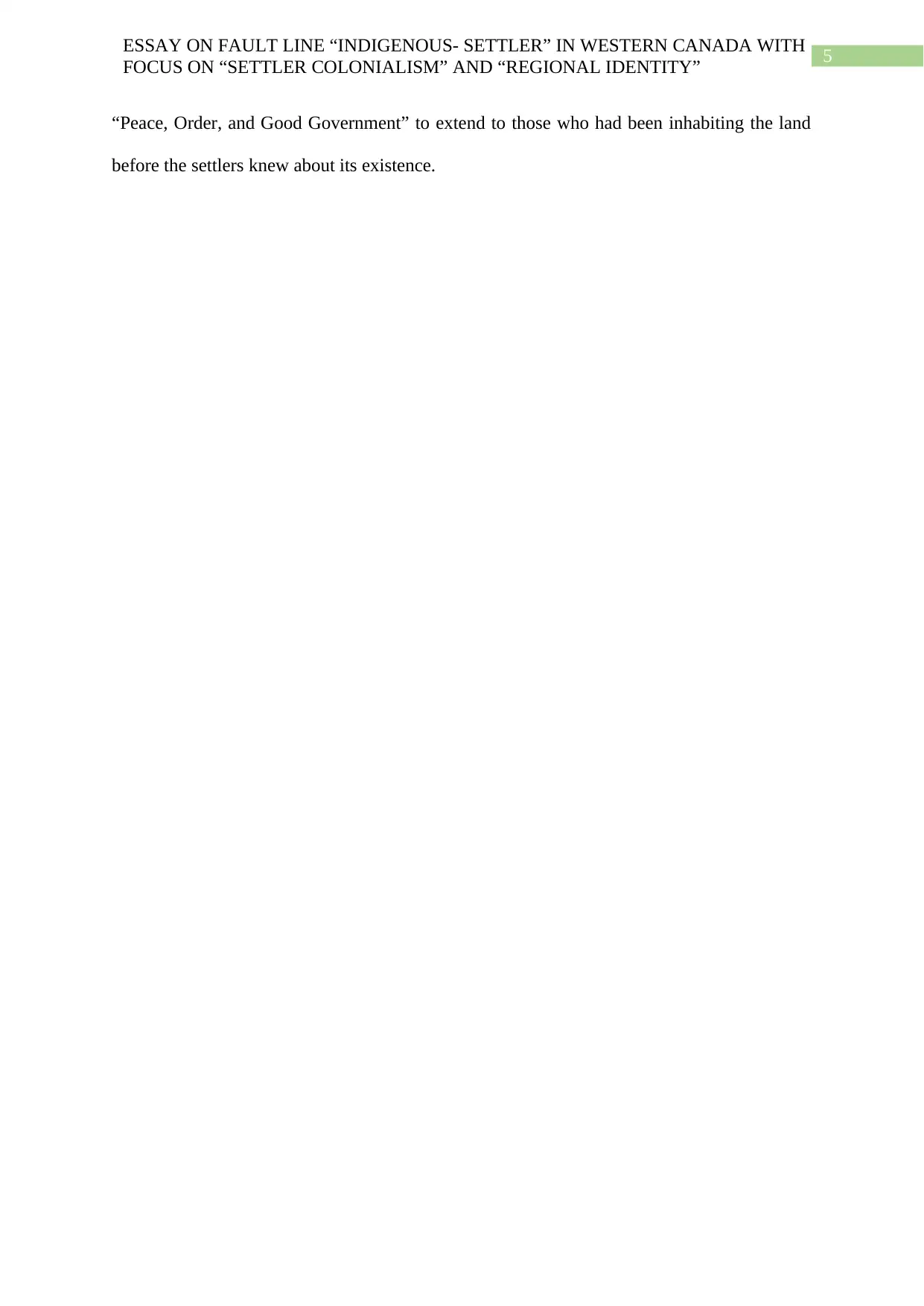
5
ESSAY ON FAULT LINE “INDIGENOUS- SETTLER” IN WESTERN CANADA WITH
FOCUS ON “SETTLER COLONIALISM” AND “REGIONAL IDENTITY”
“Peace, Order, and Good Government” to extend to those who had been inhabiting the land
before the settlers knew about its existence.
ESSAY ON FAULT LINE “INDIGENOUS- SETTLER” IN WESTERN CANADA WITH
FOCUS ON “SETTLER COLONIALISM” AND “REGIONAL IDENTITY”
“Peace, Order, and Good Government” to extend to those who had been inhabiting the land
before the settlers knew about its existence.
⊘ This is a preview!⊘
Do you want full access?
Subscribe today to unlock all pages.

Trusted by 1+ million students worldwide
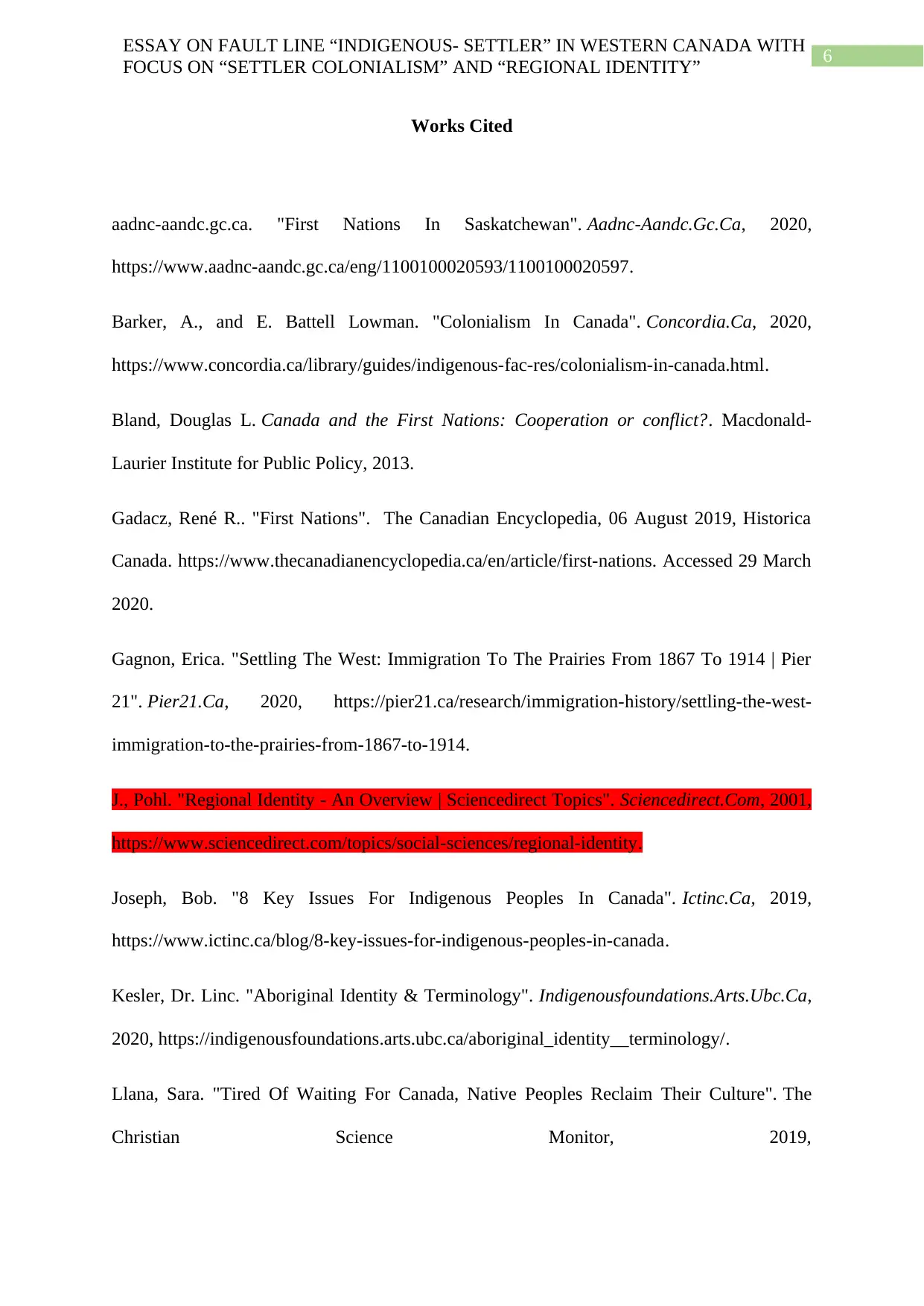
6
ESSAY ON FAULT LINE “INDIGENOUS- SETTLER” IN WESTERN CANADA WITH
FOCUS ON “SETTLER COLONIALISM” AND “REGIONAL IDENTITY”
Works Cited
aadnc-aandc.gc.ca. "First Nations In Saskatchewan". Aadnc-Aandc.Gc.Ca, 2020,
https://www.aadnc-aandc.gc.ca/eng/1100100020593/1100100020597.
Barker, A., and E. Battell Lowman. "Colonialism In Canada". Concordia.Ca, 2020,
https://www.concordia.ca/library/guides/indigenous-fac-res/colonialism-in-canada.html.
Bland, Douglas L. Canada and the First Nations: Cooperation or conflict?. Macdonald-
Laurier Institute for Public Policy, 2013.
Gadacz, René R.. "First Nations". The Canadian Encyclopedia, 06 August 2019, Historica
Canada. https://www.thecanadianencyclopedia.ca/en/article/first-nations. Accessed 29 March
2020.
Gagnon, Erica. "Settling The West: Immigration To The Prairies From 1867 To 1914 | Pier
21". Pier21.Ca, 2020, https://pier21.ca/research/immigration-history/settling-the-west-
immigration-to-the-prairies-from-1867-to-1914.
J., Pohl. "Regional Identity - An Overview | Sciencedirect Topics". Sciencedirect.Com, 2001,
https://www.sciencedirect.com/topics/social-sciences/regional-identity.
Joseph, Bob. "8 Key Issues For Indigenous Peoples In Canada". Ictinc.Ca, 2019,
https://www.ictinc.ca/blog/8-key-issues-for-indigenous-peoples-in-canada.
Kesler, Dr. Linc. "Aboriginal Identity & Terminology". Indigenousfoundations.Arts.Ubc.Ca,
2020, https://indigenousfoundations.arts.ubc.ca/aboriginal_identity__terminology/.
Llana, Sara. "Tired Of Waiting For Canada, Native Peoples Reclaim Their Culture". The
Christian Science Monitor, 2019,
ESSAY ON FAULT LINE “INDIGENOUS- SETTLER” IN WESTERN CANADA WITH
FOCUS ON “SETTLER COLONIALISM” AND “REGIONAL IDENTITY”
Works Cited
aadnc-aandc.gc.ca. "First Nations In Saskatchewan". Aadnc-Aandc.Gc.Ca, 2020,
https://www.aadnc-aandc.gc.ca/eng/1100100020593/1100100020597.
Barker, A., and E. Battell Lowman. "Colonialism In Canada". Concordia.Ca, 2020,
https://www.concordia.ca/library/guides/indigenous-fac-res/colonialism-in-canada.html.
Bland, Douglas L. Canada and the First Nations: Cooperation or conflict?. Macdonald-
Laurier Institute for Public Policy, 2013.
Gadacz, René R.. "First Nations". The Canadian Encyclopedia, 06 August 2019, Historica
Canada. https://www.thecanadianencyclopedia.ca/en/article/first-nations. Accessed 29 March
2020.
Gagnon, Erica. "Settling The West: Immigration To The Prairies From 1867 To 1914 | Pier
21". Pier21.Ca, 2020, https://pier21.ca/research/immigration-history/settling-the-west-
immigration-to-the-prairies-from-1867-to-1914.
J., Pohl. "Regional Identity - An Overview | Sciencedirect Topics". Sciencedirect.Com, 2001,
https://www.sciencedirect.com/topics/social-sciences/regional-identity.
Joseph, Bob. "8 Key Issues For Indigenous Peoples In Canada". Ictinc.Ca, 2019,
https://www.ictinc.ca/blog/8-key-issues-for-indigenous-peoples-in-canada.
Kesler, Dr. Linc. "Aboriginal Identity & Terminology". Indigenousfoundations.Arts.Ubc.Ca,
2020, https://indigenousfoundations.arts.ubc.ca/aboriginal_identity__terminology/.
Llana, Sara. "Tired Of Waiting For Canada, Native Peoples Reclaim Their Culture". The
Christian Science Monitor, 2019,
Paraphrase This Document
Need a fresh take? Get an instant paraphrase of this document with our AI Paraphraser
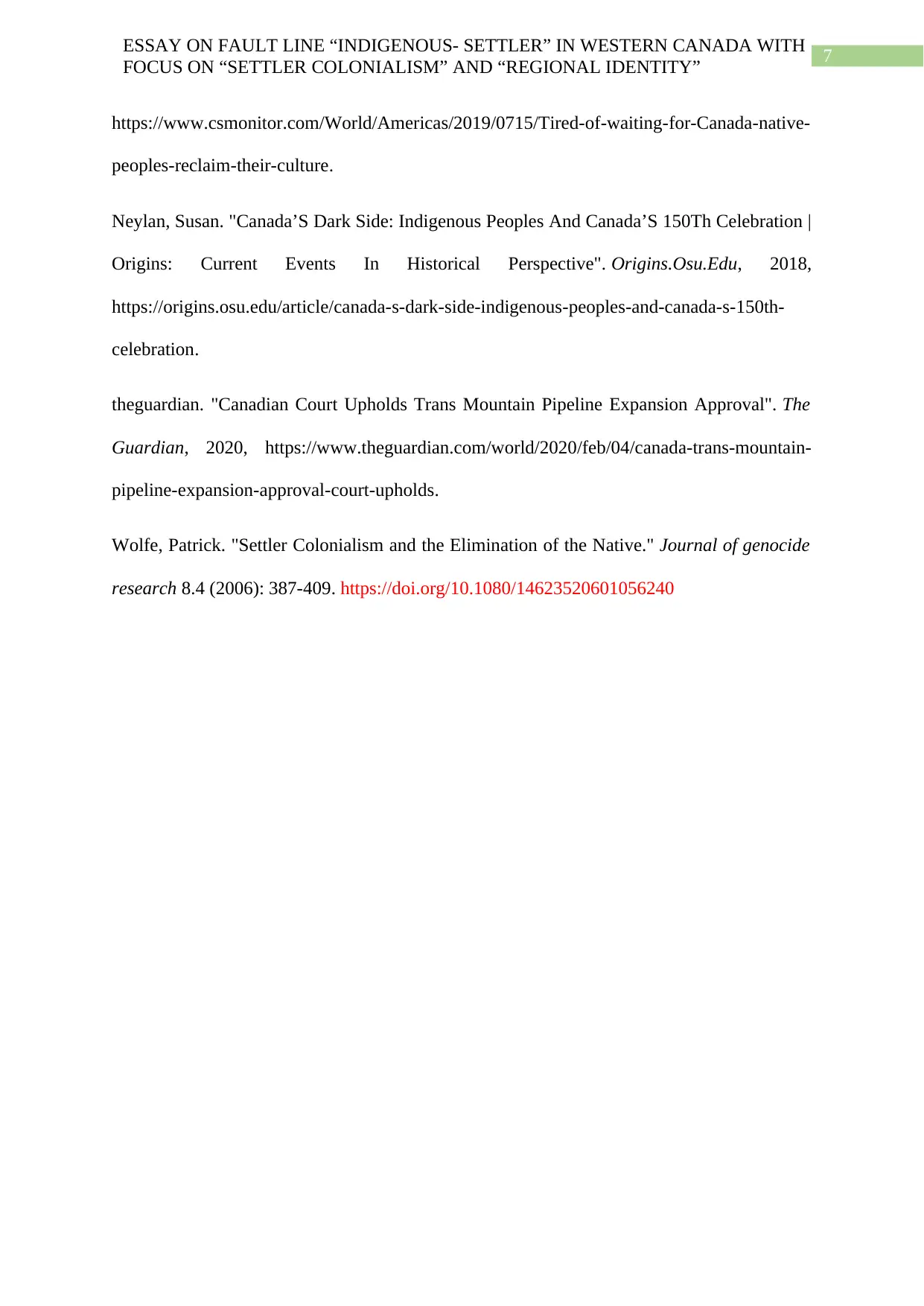
7
ESSAY ON FAULT LINE “INDIGENOUS- SETTLER” IN WESTERN CANADA WITH
FOCUS ON “SETTLER COLONIALISM” AND “REGIONAL IDENTITY”
https://www.csmonitor.com/World/Americas/2019/0715/Tired-of-waiting-for-Canada-native-
peoples-reclaim-their-culture.
Neylan, Susan. "Canada’S Dark Side: Indigenous Peoples And Canada’S 150Th Celebration |
Origins: Current Events In Historical Perspective". Origins.Osu.Edu, 2018,
https://origins.osu.edu/article/canada-s-dark-side-indigenous-peoples-and-canada-s-150th-
celebration.
theguardian. "Canadian Court Upholds Trans Mountain Pipeline Expansion Approval". The
Guardian, 2020, https://www.theguardian.com/world/2020/feb/04/canada-trans-mountain-
pipeline-expansion-approval-court-upholds.
Wolfe, Patrick. "Settler Colonialism and the Elimination of the Native." Journal of genocide
research 8.4 (2006): 387-409. https://doi.org/10.1080/14623520601056240
ESSAY ON FAULT LINE “INDIGENOUS- SETTLER” IN WESTERN CANADA WITH
FOCUS ON “SETTLER COLONIALISM” AND “REGIONAL IDENTITY”
https://www.csmonitor.com/World/Americas/2019/0715/Tired-of-waiting-for-Canada-native-
peoples-reclaim-their-culture.
Neylan, Susan. "Canada’S Dark Side: Indigenous Peoples And Canada’S 150Th Celebration |
Origins: Current Events In Historical Perspective". Origins.Osu.Edu, 2018,
https://origins.osu.edu/article/canada-s-dark-side-indigenous-peoples-and-canada-s-150th-
celebration.
theguardian. "Canadian Court Upholds Trans Mountain Pipeline Expansion Approval". The
Guardian, 2020, https://www.theguardian.com/world/2020/feb/04/canada-trans-mountain-
pipeline-expansion-approval-court-upholds.
Wolfe, Patrick. "Settler Colonialism and the Elimination of the Native." Journal of genocide
research 8.4 (2006): 387-409. https://doi.org/10.1080/14623520601056240
1 out of 8
Your All-in-One AI-Powered Toolkit for Academic Success.
+13062052269
info@desklib.com
Available 24*7 on WhatsApp / Email
![[object Object]](/_next/static/media/star-bottom.7253800d.svg)
Unlock your academic potential
Copyright © 2020–2025 A2Z Services. All Rights Reserved. Developed and managed by ZUCOL.
